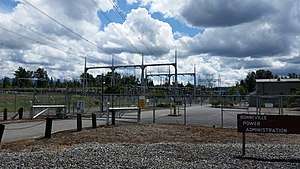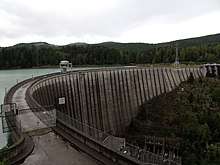Electricity in the Puget Sound region
Electricity in the Puget Sound region is a significant factor in people's lives, an enabler for the modern economy, and has a unique relationship with the region's environment.

Suppliers include both public and private entities. Public entities include Seattle City Light and Tacoma Power, and several public utility districts. Private entities include Puget Sound Energy (PSE), formerly Puget Power. The largest suppliers are PSE with 1.1 million customers, or about a quarter of the population of the region,[lower-alpha 1] Seattle City Light with the city's entire population and some nearby areas totaling over 770,000 customers,[3] and Snohomish County Public Utility District with 325,000 and Tacoma Power with 179,000.[4]
History
Seattle was electrified since shortly after its incorporation in 1869.[lower-alpha 2] Gas street lamps were installed in part of the downtown area in 1874,[6] but by 1886 (four years after Pearl Street Station was built in New York), the Seattle Electric Light Company had created the first incandescent lighting system west of the Rockies;[7] in 1889 the James Street line became the first electric streetcar in the city.[8]
Abundant electricity allowed local industries like Boeing to develop, and contributed to transportation such as the city's extensive electric trolley system and regional transportation like the Cascade Tunnel which exclusively carried an electric railway until the 1950s.
Some early hydroelectric projects like the now demolished Elwha Dam were built to power lumber mills, at one time at the root of the region's economy.[lower-alpha 3]
Sources and costs

The Puget Sound region consumes more electricity than it produces. The vast majority of the region's electricity is hydroelectricity from the Columbia River, with a contribution from Washington wind power and nuclear as well as local combined cycle natural gas, and some electricity is available via interties from Southern California in the winter (see Western Interconnection).[10][11] Costs are among the lowest in the nation at an average 7.6 cents per kilowatt-hour in 2016.[12] Historically this has been due to the large supply from public utility-owned sources.[lower-alpha 4]
Regulation
Three investor-owned electric utilities in Washington (Avista (formerly Washington Water Power), PacifiCorp (formerly Pacific Power and Light Company), and Puget Sound Energy (PSE)) are regulated by the Washington Utilities and Transportation Commission (WUTC) which sets rates.[12] Of the three only PSE operates in the Puget Sound area.
PUDs

Public utility districts are independent taxation and regulation authorities and are not regulated by WUTC.[12] All Puget Sound counties except Pierce and King have their own Public Utility District.[14] The PUDs serve about one million customers across the entire state.[15]
Net metering
Net metering up to 100 kW per customer is mandated to investor-owned energy companies by the state legislature, to include PSE in the Puget Sound region.[16] Seattle City Light also participates in net metering.[17] Net metering makes rooftop photovoltaic power (solar power) attractive to some homeowners in the Puget Sound area, although the region does not receive intense sun in the winter due to latitude and climate.[18]
Environment and treaty rights
Environmental protection, especially of endangered salmonids, environmental restoration, and Native American treaty rights are of concern to many communities of interest in the Puget Sound region.[19][20] The Federal Energy Regulatory Commission is a regulator that will be involved in future decision making. As of 2017, plans are underway to conduct restoration after decommissioning of the White River Hydroelectric Project.[21]
Infrastructure
Hydroelectric

Seattle City Light owns considerable infrastructure including the Skagit River Hydroelectric Project and high voltage transmission system. Tacoma Power owns Cushman Dam No. 1 and Cushman Dam No. 2 at Lake Cushman in the foothills of the Olympic Mountains. There is one coal power plant in the Puget Sound area, Centralia Power Plant, scheduled for shutdown by 2025. Packwood Lake Hydroelectric Project is owned by Energy Northwest (formerly Washington Public Power Supply System) which also operates a nuclear reactor in Eastern Washington. Snoqualmie Falls Hydroelectric Plant, which came online in 1899, is and the first underground power station in the world, and one of the first to use alternating current and aluminum long-distance transmission wires (to Seattle).[22] Smaller hydroelectric facilities include Alder Dam on the Nisqually River, Nooksack Falls Hydroelectric Power Plant, Henry M. Jackson Hydroelectric Project on the Sultan River, Electron Hydroelectric Project on the Puyallup River, and Koma Kulshan Project on Mount Baker.
Transmission
Bonneville Power Administration owns a great deal of high-voltage transmission equipment and rights of way in the region. The last major transmission line west of the Cascades was built in the 1970s and a proposal to build a new 80-mile (130 km) 500 kV line between Castle Rock and Troutdale (near Portland) was killed in 2017.[23]
Proposed or abandoned nuclear plants
In 1969 the Seattle City Council approved purchase of Kiket Island to build two city-owned nuclear power plants, but the plan was dropped before construction began. Instead, Seattle began an intensive energy conservation campaign called Kill-A-Watt.[24][25] Another plan to build a Skagit Nuclear Power Plant also never materialized. The Satsop Nuclear Power Plant west of Olympia was conceived in the early 1970s partly in response to inadequate power resources in the region, and canceled after more than five years of construction during the early 1980s recession due to decreased demand and stagflation, resulting in the largest municipal bond default in history at the time.[26][27] As of 2017, Columbia Generating Station at the Hanford Site is the only nuclear power reactor in Washington and there are no nuclear power plants in Western Washington.[28][lower-alpha 5]
Other proposals
Proposed future infrastructure includes the Juan de Fuca Cable Project, an underwater high voltage DC intertie crossing Strait of Juan de Fuca to Vancouver Island in Canada, which would supply Puget Sound consumers with abundant Canada wind power. Tidal power has also been proposed as a future source, and a pilot tidal turbine project undertaken by Snohomish County PUD, said to be the first of its kind in the world, was abandoned in 2014.[29][30]
Reliability
Climate and weather effects

Pacific Northwest windstorms, usually in the late fall and early winter, can result in power outages affecting hundreds of thousands of people at a time in the Puget Sound region. Half of Seattle was without electric power after the Hanukkah Eve windstorm of 2006.[31] 463,000 were without power in the Puget Sound area and an additional 500,000 in southern British Columbia after an unusually early windstorm in late August, 2015.[32][33] 750,000 people were without electric power after the January 20, 1993 Inaugural Day Storm.[34] The Columbus Day Storm of 1962 left one million people without electric power in Oregon and Washington,[35][36] including nearly all of Tacoma and much of Seattle, and complete outage at Seattle-Tacoma International Airport.[37][38]
System capacity and reliability
Beginning in 1989 when record electric consumption was recorded for cold-weather heating (the region uses electric space heating extensively), and following rapid population growth, the regional system was deemed "severely stressed"; in 1990 it was several hundred megawatts over its reliable peak limit.[39] Also beginning in the late 20th century, interconnections to other regional grids made summer power outages like one in 1996 possible.[40]
Notes
- 1.1 million PSE customers,[1] of the residents of Puget Sound region defined by Seattle–Tacoma–Olympia Combined Statistical Area, population 4.3 million in 2012[2]
- The city was re-incorporated in 1869 and bears this year on its seal.
- "Socially as well as economically, lumber has exerted important influences in the life of the State." – Federal Writers' Project[9]
- "[Tacoma] has a municipally owned power plant which distributes electricity at one of the lowest rates in the United States" – Federal Writers' Project[13]
- Western Washington has had research reactors e.g. More Hall Annex at the University of Washington in Seattle
References
- About Us, Puget Sound Energy, archived from the original on 2017-10-01, retrieved 2017-09-18
- "Seattle–Tacoma–Olympia Combined Statistical Area data", US Factfinder, US Census Bureau, archived from the original on 2017-07-31, retrieved 2017-10-12
- Annual Report, Seattle City Light, 2015, retrieved 2017-09-18
- About Tacoma Power, Tacoma Power, retrieved 2017-09-18
- "History Lives Here" Walking Tour Centennial Markers: Snoqualmie Falls Power Co. Substation, City of Renton, archived from the original on 2016-10-21, retrieved 2017-09-18
- WPA Guide 1941, p. 209.
- A brief history of City Light, Seattle City Light, retrieved 2017-09-18
- Kery MURAKAMI (November 16, 2005), "Seattle's first electric streetcar zipped up James Street in 1889", Seattle Post-Intelligencer
- WPA Guide 1941, p. 179.
- ELECTRICITY GENERATION FOR THE PACIFIC NORTHWEST, Northwest Power and Conservation Council, March 1, 2011
- BPA EIS 1992, p. 1-8 to 1-10.
- Energy policy in Washington, Ballotpedia
- WPA Guide 1941.
- Washington PUD map and member registry, Washington PUD Association
- About PUDs (PDF) (factsheet), Washington PUD Association, December 2011, retrieved 2017-09-18
- Net Metering, Washington Utilities and Transportation Commission, retrieved 2017-09-18
- Solar FAQ, Seattle City Light
- Nancy Chaney (April 19, 2008), "Solar power in Seattle? It may not boost a home's price but can cut energy bills", The Seattle Times
- Ecosystems & Fish, National Hydropower Association, retrieved 2017-09-19
- Sally Jewell (September 12, 2016), Obsolete Dams are a Hazard to People and Wildlife. We're Working Together to Remove Them. (official blog), United States Department of Interior
- White River Hydroelectric Project, Seattle: NOAA Fisheries West Coast Region, retrieved 2017-09-19
- "Snoqualmie Falls: One man's vision", Water Power and Dam Construction, January 4, 2012
- Dameon Pesanti (May 18, 2017), "BPA drops I-5 Corridor Reinforcement Project", The Columbian, Vancouver, Washington
- David Wilma (October 24, 2001), Seattle City Light approved to purchase Kiket Island for a proposed nuclear power plant on June 30, 1969, HistoryLink
- David Wilma (December 27, 2000), Seattle City Light inaugurates Kill-A-Watt to conserve electricity on July 17, 1973., HistoryLink
- Pope, Daniel (2008), Nuclear Implosions: The Rise and Fall of the Washington Public Power Supply System, Cambridge University Press, p. 210, ISBN 978-0-521-40253-8
- "The "Whoops" Bubble Bursts", Newsweek, p. 61, August 8, 1983 – via Internet Archive,
By last year, recession had sapped the demand for energy, and the region had no need for the additional capacity.
- List of power reactors (region 4), Nuclear Regulatory Commission, retrieved 2017-09-18
- "Tidal energy in Puget Sound", Encyclopedia of Puget Sound
- Courtney FLATT (October 1, 2014), Tidal Power Project In Puget Sound Abandoned By Utility, KUOW-FM
- Windstorms, City of Seattle Department of Emergency Management
- "2 people killed in Seattle-area windstorm identified", The Seattle Times, August 29, 2015
- Daniel Martins (September 1, 2015), B.C. got more rain in four days than the whole summer, The Weather Network
- Wolf Read (March 5, 2003), The Devastating Inaugural Day Storm of 1993, University of Washsington
- Stacia Glenn (October 12, 2012), "Memories of devastating 1962 Columbus Day storm run deep through Pacific Northwest", Tacoma News-Tribune – via Tri-City Herald
- Stuart Tomlinson (October 7, 2012), Columbus Day Storm still howls through Portland history, 50 years later, Portland: The Oregonian
- Alan J. Stein (August 5, 2012), Columbus Day windstorm ravages Puget Sound region on October 12, 1962, HistoryLink
- "'Murderous' Columbus Day Storm of 1962 was spawned by similar typhoon now looming over Pacific", The Seattle Times, October 12, 2016
- BPA EIS 1992, pp. 1-2, 1-5 and 1-6.
- Power and Utility Failures, Kitsap Peninsula, Washington: Peninsula Emergency Preparedness Coalition, archived from the original on 2017-10-26, retrieved 2017-09-18,
A seemingly new kind of outage was prevalent during the summer of 1996 when problems with line loading caused major regional power outages along the west coast.
Sources
- Federal Writers' Project (1941), The WPA Guide to Washington: The Evergreen State, American Guide Series
- Bonneville Power Administration (April 1992), Puget Sound Area Electric Reliability Plan, EIS-0160 – via US Department of Energy Office of NEPA Policy and Compliance
